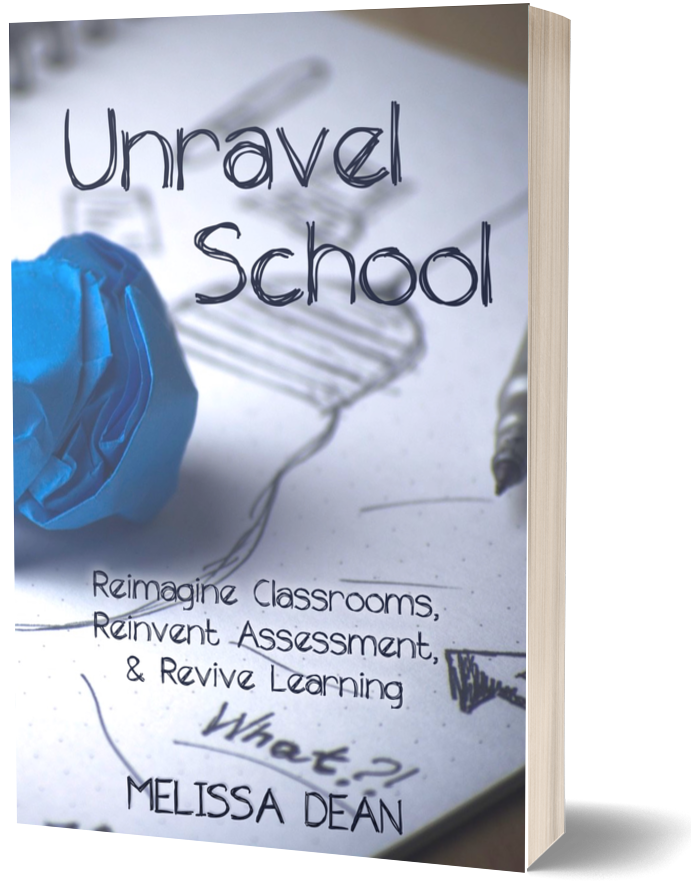“We don’t need school;
we just need learning.”

For far too long, school and learning have been disconnected from each other, when exactly the opposite should be true. There are many many threads we could pull on to unravel the foundation and reset the system. The key thread? Assessment and Evaluation. Upon close inspection, the foundation of our system is closely linked to our beliefs about assessment and evaluation. This tightly woven thread holds learning captive as we try to shift our thoughts about learning without braving the necessary change in assessment and feedback practices. It can be hard to know where the starting line is. This book is a primer for starting to unravel assessment and evaluation and starting a journey towards free and open learning within your classroom. Look for Melissa Dean’s Unravel School coming to our Code Breaker library this month.
March Guest Blogger: Melissa Dean
The Problem with 100%
One day a past principal of mine asked me, mid-conversation, if I thought it was possible for a student to get 100% in my class. I said no. He asked me to explain myself. I was still relatively new in my teaching career and I had strong convictions about grades and 100% as a final grade in a class or, to be honest, on a test or an assignment. 100%, particularly as a final grade, seems to imply that there is no more learning to be done. Can we really say this about a student? Even in a discipline like math that, in the minds of many, is cut and dry, black and white? This was, in essence, my response to my principal. His response is something I’ve never forgotten — “Why are we holding kids to an impossible standard then?” Touché, Mr. Matt, touché.
But, really, are we holding kids to a standard that we also don’t think or want them to really meet? There are so many things to think about with this. I still hold pretty strongly to the conviction that 100% as a final grade in a class is not a thing that is really valid. To start with, there’s the issue with how grades are determined. There are a whole lot of grades that are determined by weights, and averages and calculations done by a computer program. If there is one thing I’d like to say louder for the people in the back it’s this: GRADES SHOULD NEVER BE DETERMINED BY AVERAGING A BUNCH OF SCORES TOGETHER. #shoutycapsforemphasis
So, how should grades be calculated then? This, friends, is one of the holy grails of education, in any discipline. I mean, to be honest, I want my answer to be, they shouldn’t be. Grades just shouldn’t be calculated period, because grades are a false construct. If we’re honest with ourselves, and I hope that we are, those numbers don’t really mean what we think they mean, and they certainly don’t mean what our students think they mean. Our reality, however, is that we must assign grades, so if we’re going to have to do something, we might as well do it well. If we’re going to do it well, we need to know what it is those numbers are supposed to represent.
Why do we assess in the first place?
To tackle this question, we need to come back to the purpose of assessment (of, as, and for learning). After any assessment, our learners should be able to answer three questions: What do I know right now? What do I need to know next? How am I going to get there? 56/60 on the top of a page doesn’t answer any of those questions. And 60/60 doesn’t either. It really doesn’t tell you as the lead learner in the room all that much either.
I’ve gone on a tangent, so let’s come back to that notion of 100% for a moment. What does it mean? If a student sees 100% on a test, what does that mean? Does it mean that they have mastered that content? That outcome? Maybe — it really depends on what kinds of questions they were being asked. If those questions are all basic expectations based on memorized procedural understanding, well, then that 100% means that they have memorized the steps, but they may have no actual concept of what was being learned. Conversely, a score of 45% might mean that student didn’t understand the concept, or it might mean that the student answered the questions in a way that didn’t match the predetermined answer key. How will we know for sure? Conversation. Observation. And a carefully curated body of evidence of that student’s learning journey.
If we tell a student that their grade is 100%, what are we telling them? Well, they see 100% and think, I’m done here. My learning has ended. Any number tells them that — learning doesn’t continue based on the number. And if they get 100% as a final evaluation, does that tell them that they have learned all there is to know? I would argue there is always more learning to be done. We can always refine and grow and develop as a communicator, collaborator, and a conjecturer. That is what mathematics is really about. It’s what all learning is about.
We want marking to be cut and dry. It’s not. Learning isn’t cut and dry. A student’s journey to learning isn’t straight. It’s not perfect. There are curves, and detours, and mistakes, and traumas that send averages off course. An average of a bunch of numbers, even all good numbers, isn’t the whole picture. There is more to know, and more to see. And we never want a student to end their learning. No number on a page should have that impact. We must carefully consider what messages our numbers are sending.
